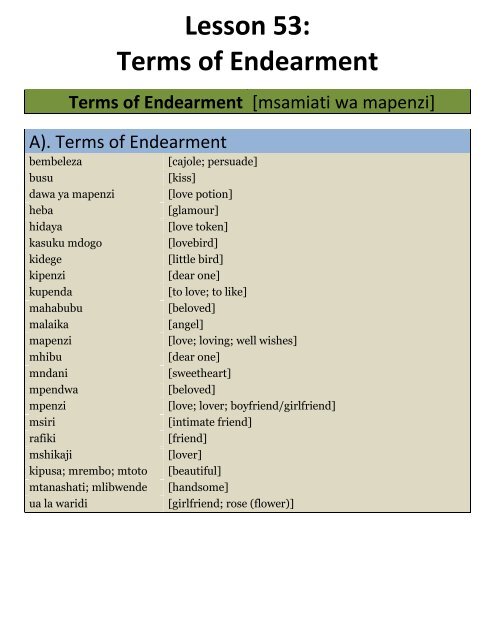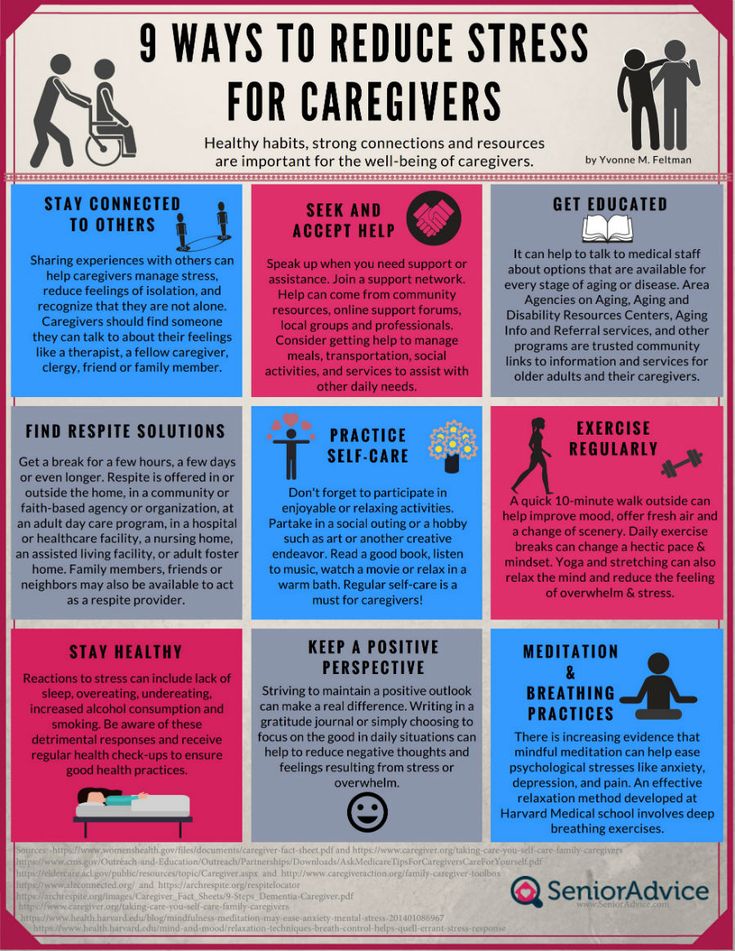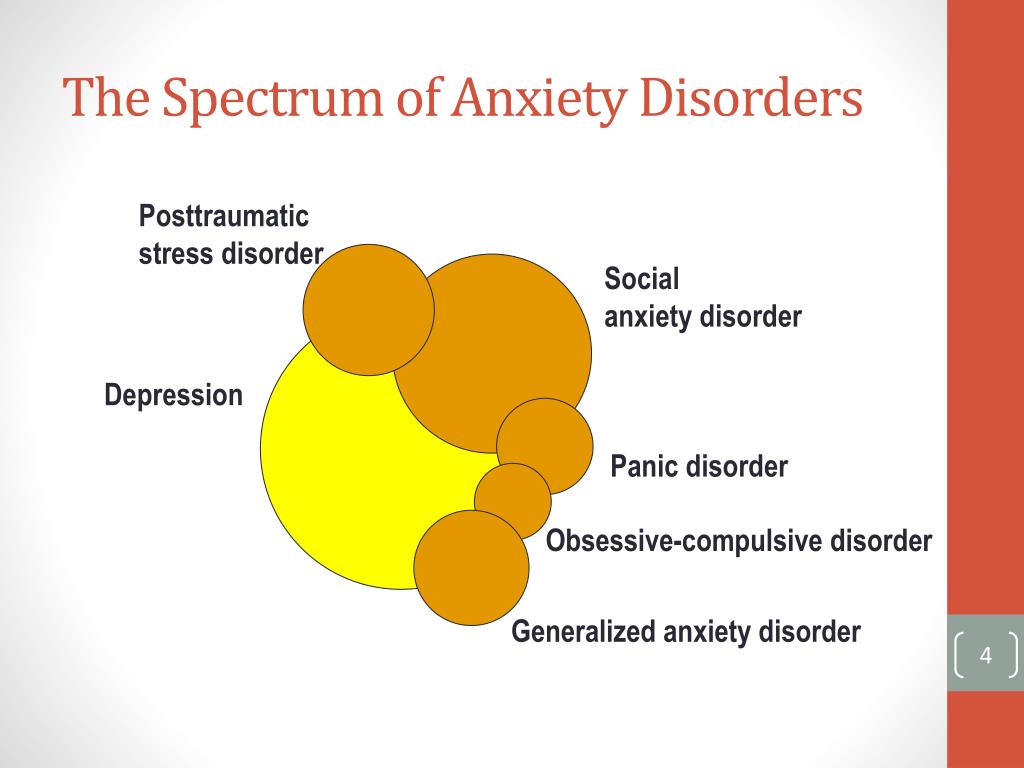F code for generalized anxiety disorder
Anxiety ICD 10
ICD 10 Codes Mental Health Therapy Billing 
Anxiety ICD 10, types of anxiety disorders and their corresponding ICD-10 codes will be discussed in this article. In addition, we will cover inclusion criteria for each disorder.
We have all felt anxious at some point in our lives. But for many people, anxiety can be highly debilitating. It is estimated that over 30 percent of American adults will experience an anxiety disorder during their lifetime.
Mental health professionals are given the difficult task of evaluating clients and providing an appropriate diagnosis. Fortunately, they do have help.
The International Statistical Classification of Diseases and Related Health Problems 10th Revision (ICD-10) categorizes multiple types of ICD 10 anxiety and associated criteria to aid clinicians in the assessment of anxiety disorders.
The codes in the ICD-10 serve multiple purposes. First, they provide specific diagnoses that provide a path towards treatment.
Second, these same codes are used for insurance billing. An accurate diagnosis can have a major impact on developing an effective treatment plan as well as obtaining financial reimbursement. Here is what you need to know about diagnosing anxiety disorders using the ICD-10.
What is the ICD 10 code for Anxiety ?
Anxiety disorders are those where anxiety is the major symptom and can occur in a variety of situations. The following are among the most common anxiety disorders as listed in the ICD-10.
Here is a handy table that lists types of Anxiety ICD 10:
Type of Anxiety Disorder | ICD - 10 Code |
|---|---|
Generalized Anxiety Disorder | F 41.1 |
Panic Disorder | F 41.0 |
Social Phobia | F 40.1 |
Specific (Isolated) Phobias | F 40.2 |
F41.1 Generalized Anxiety Disorder (GAD)
Generalized anxiety disorder is the most often used ICD-10 code for mental health disorders.
It is estimated that 2.7 percent of adults have had GAD in the past year and 5.7 percent will experience it at some point in their lifetime.
Criteria:- At least six months with significant tension, worry, and feelings of apprehension, about everyday events and problems.
- At least one symptom out of the following list of items must be present: palpitations or pounding heart, accelerated heart rate, sweating, and trembling or shaking.
- Including those symptoms stated above, at least three other symptoms must be present.
These may include:
- Dry mouth
- Difficulty breathing
- Feeling of choking
- Chest pain or discomfort
- Nausea or abdominal distress
- Feeling dizzy
- Derealisation or depersonalization
- Fear of losing control, passing out, or dying
- Hot flushes or cold chills
- Numbness or tingling sensations
Some clinicians make the mistake of using GAD as a throwaway diagnosis.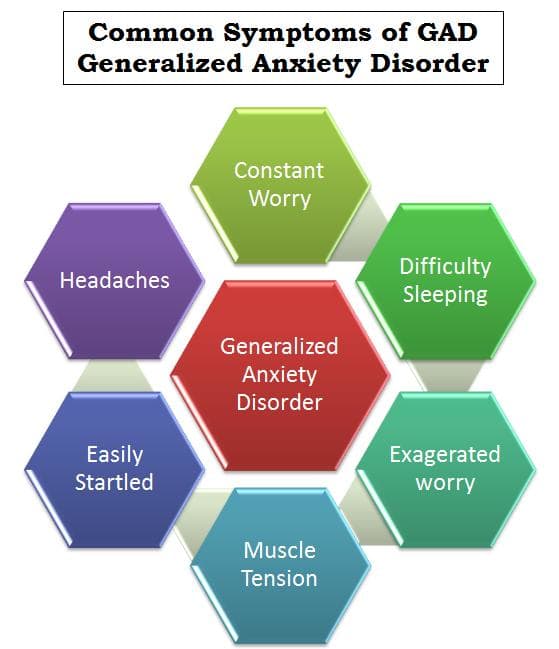 The thinking goes something like this: If a client has some sort of anxiety but it doesn’t fit into another anxiety disorder then it must be GAD.
The thinking goes something like this: If a client has some sort of anxiety but it doesn’t fit into another anxiety disorder then it must be GAD.
While GAD does reflect a more generalized form of anxiety, it does have specific criteria that must be met. It is not the same as F41.9, anxiety disorder unspecified, but is often used like it.
Start 30-day Free Trial and explore TheraPlatform. HIPAA Compliant Video and Practice Management Software for Therapists.
Free Trial
F41.0 Panic DisorderPanic disorder is one of the scariest anxiety disorders. It has been described as feeling out of control, possibly like a heart attack. An estimated 2.7 percent of U.S. adults had panic disorder in the past year and 4.7 percent experience panic disorder at some time in their lives.
Criteria:- Recurrent attacks that are not consistently associated with a specific situation or object, and often occur spontaneously.
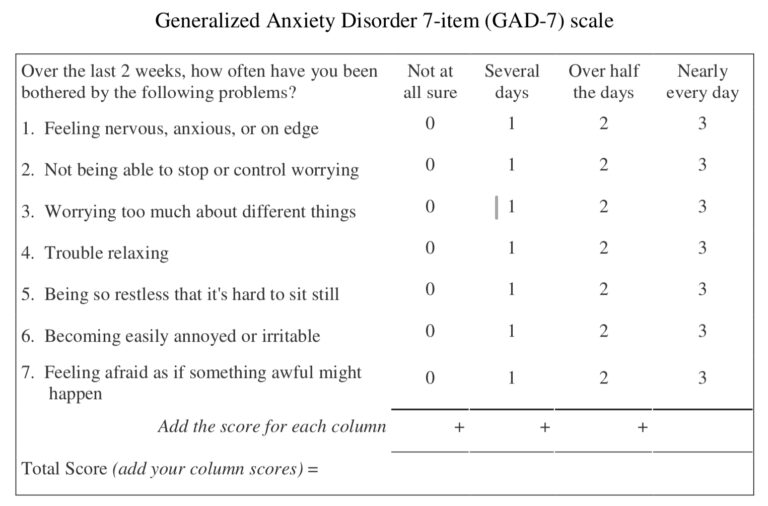
- At least four symptoms must be present, one of which must be an autonomic arousal symptom such as heart palpitations, sweating, trembling or shaking, and dry mouth.
- Other symptoms may include chest pain, numbness, nausea, stomach problems, dizziness, depersonalization, fear of losing control, and fear of dying.
A panic attack is characterized by all of the following:
- An episode of intense fear or discomfort
- Starts abruptly, often without any warning.
- Escalates to a peak within a few minutes and lasts at least several minutes
The most important consideration with panic disorder is that physical problems must be ruled out. Autonomic arousal, for example, might be caused by health conditions rather than be related to anxiety.
It is not uncommon for many clients to have already seen a doctor about these symptoms before seeking help from a mental health professional.
F 40.1 Social Phobia (Social Anxiety Disorder)
To avoid any confusion, you need to know that social phobia is also known as social anxiety disorder.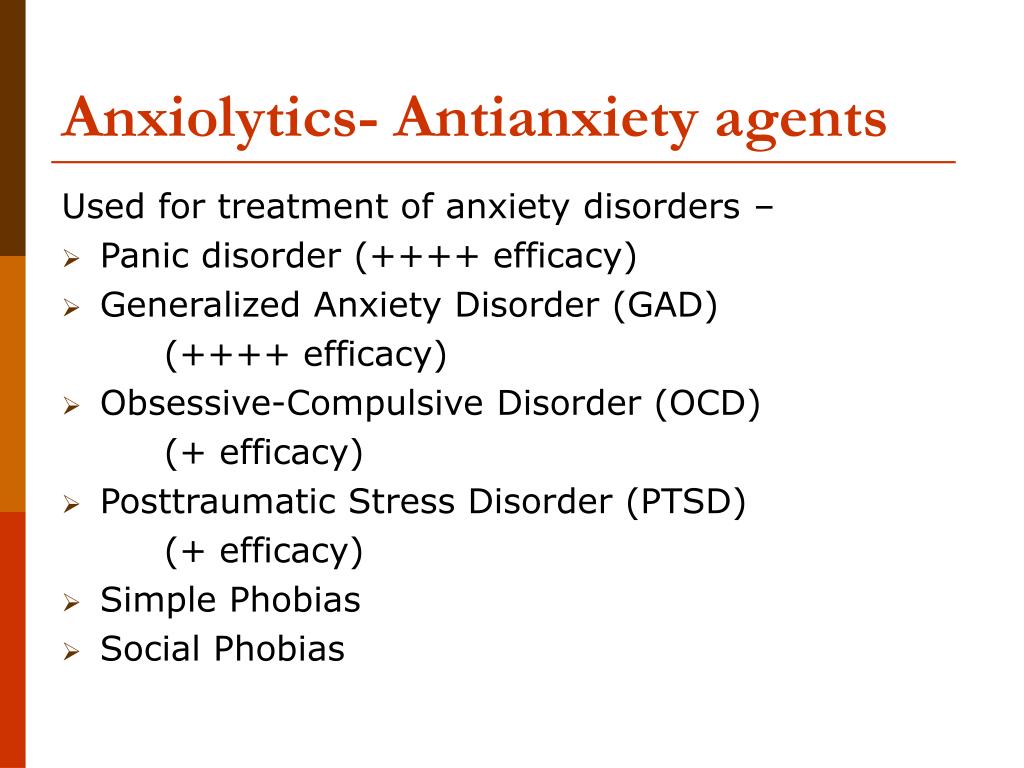 In fact, the Diagnostic and Statistical Manual of Mental Disorders, Fifth Edition (DSM-V) refers to it as social anxiety. An estimated 7.1% of U.S. adults had social phobia disorder in the past year and a whopping 12.1 percent of U.S. adults experience social phobia at some time in their lives.
In fact, the Diagnostic and Statistical Manual of Mental Disorders, Fifth Edition (DSM-V) refers to it as social anxiety. An estimated 7.1% of U.S. adults had social phobia disorder in the past year and a whopping 12.1 percent of U.S. adults experience social phobia at some time in their lives.
- One of the following two symptoms must be present for the diagnosis of social phobia. These fears must be exhibited in social situations, such as speaking in public and enduring gatherings such as parties, meetings, and classrooms.
- Significant fear of being the focus of attention or behaving in a way that will be embarrassing or humiliating.
- Significant avoidance of being the focus of attention or situations in which there is fear of behaving in an embarrassing or humiliating way.
- Significant emotional distress is caused by the symptoms or the avoidance of the situation.
- Symptoms only occur when confronting the anxiety-provoking situation or thinking about it.

At least two symptoms of anxiety (see #2 for GAD above) will be present when confronting the feared situation. In addition, one of the following symptoms is included:
- Blushing
- Fear of vomiting
- Urgency or fear of urination or defecation
The key to a correct diagnosis of social phobia is the severity of the disorder. Many people have anxiety in social groups or when they are made the center of attention (e.g., giving a speech in public).
What sets social phobia apart is the lengths someone will go to to avoid those situations. Or, how they feel incapacitated if they find themselves unable to escape.
F40.2 Specific (Isolated) Phobias
Specific phobias are the most common of all anxiety disorders. An estimated 12.5 percent of American adults experience specific phobia at some time in their lives. The concept of specific phobia is familiar to most people and may include intense fear of heights, blood, and snakes.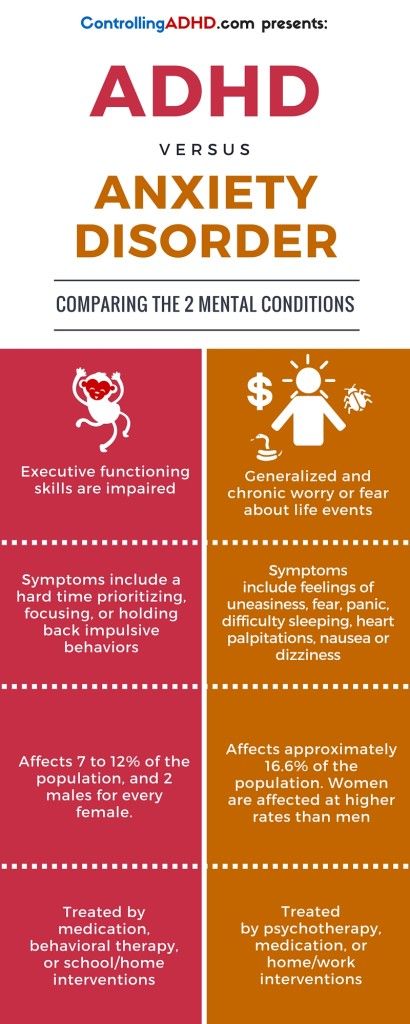
- A chronic fear of a specific object or situation that is excessive or unreasonable.
- Exposure to the feared item or situation almost always leads to an immediate anxiety response, which may rise to the level of a panic attack.
- The person recognizes that the fear is excessive compared to the actual threat posed.
- The phobic situation is either avoided or endured with intense distress.
- The avoidance or distress during the feared situation interferes significantly with the person's normal functioning.
- The fear lasts for at least six months.
Like social phobia, the key to a correct diagnosis of a specific phobia is recognizing its severity. Many people have a fear of needle injection, for example, but not everyone will avoid it at any cost.
Individuals with specific phobias experience significant disruption to their lives when confronted with anxiety-provoking stimuli. What is more frustrating, they realize that their fear is often irrational.
What is more frustrating, they realize that their fear is often irrational.
Where are Obsessive-Compulsive Disorder (OCD) and Post-Traumatic Stress Disorder (PTSD)?
In the original composition of the ICD-10, OCD and PTSD were indeed considered anxiety disorders. In recent years, however, both disorders have been given their own category. Although anxiety remains a main component of both OCD and PTSD, it has been decided that there are many additional facets to those disorders that make them unique.
Anxiety is one of the most common and serious problems affecting people worldwide. Proper anxiety ICD-10 diagnosis is integral for both treatment planning and insurance reimbursement.
More Resources
As a practitioner, you want practice software that will help you easily find ICD-10 codes and transfer them to paperwork.
TheraPlatform (practice management + EMR + telehealth software) provides effortless lookup of ICD-10 codes and will auto-populate them to the relevant documentation, billing, and claims.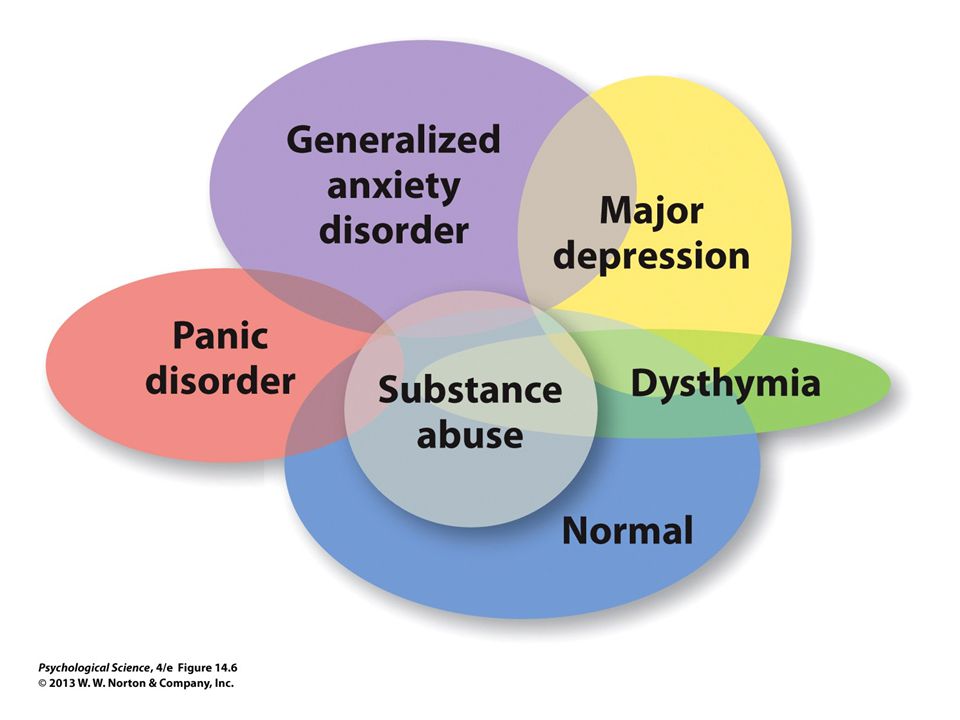 After all, why make life more difficult than it has to be? Sign up for a free 30-day trial today. No credit card is needed!
After all, why make life more difficult than it has to be? Sign up for a free 30-day trial today. No credit card is needed!
Our top articles for you regarding mental health CPT codes:
Psychotherapy CPT Codes
90847 CPT code and 90846 CPT Code
Practice Management, EHR/EMR and Teletherapy Platform
Start 30 Day FREE TRIAL
4/9/2019
SOAP notes counseling
SOAP notes are probably one of the most tedious and confusing things we, therapists and counselors do. Review the format and tips on writing SOAP notes in counseling.
3/1/2021
Counseling Treatment Plan
Counseling (mental health) treatment plan; rational, tips and how to document treatment plan to help with insurance audits will be covered in this blog. If you have ever had an ongoing relationship with a client, you likely have created a treatment plan. Counseling treatment plans serve a valuable purpose: they help both clients and practitioners understand the course of treatment. Let’s take a closer look at the features of these important documents.
If you have ever had an ongoing relationship with a client, you likely have created a treatment plan. Counseling treatment plans serve a valuable purpose: they help both clients and practitioners understand the course of treatment. Let’s take a closer look at the features of these important documents.
Therapy Games Teletherapy Therapy Notes Telepractice Marketing For Therapists Starting a Private Practice Resources For Therapists Behavioral Health Therapy Billing Case Studies Telehealth Physical Therapy CPT Codes ICD 10 Codes Speech Therapy ICD 10 Codes Physical Therapy ICD 10 Codes Mental Health Mental Health Assessments CPT Codes Mental Health Practice Management Types Of Therapy Occupational Therapy Speech Therapy Physical Therapy Cognitive Behavioral Therapy Therapy Intake Forms Therapy Treatment Plans Therapy Goals
Subscribe to our newsletter
Coding for Anxiety Disorders
October 8, 2012
Coding for Anxiety Disorders
For The Record
Vol.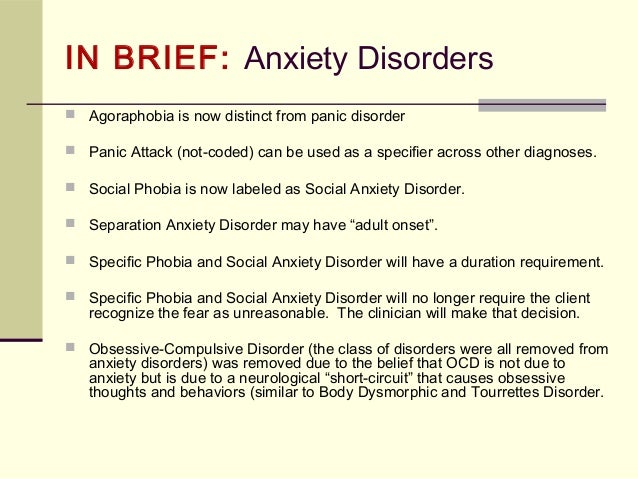 24 No. 18 P. 26
24 No. 18 P. 26
Anxiety is a feeling of uncontrollable nervousness, fear, apprehension, and worry that can range from mild unsettling to severe debilitation. Anxiety occurs normally in everyday life and is useful when alerting a person to danger, but it becomes concerning when it disrupts normal activities. The exact cause of anxiety is unknown, but it is believed stress may be one trigger.
Forms of Anxiety
The following are some common forms of anxiety with their associated ICD-9-CM code:
• Generalized anxiety disorder (300.02) — involves six months of persistent, excessive, and unrealistic worry.
• Panic disorder (300.01) — may have a sudden onset causing apprehension, fear, or terror. Physical symptoms may include shortness of breath, heart palpitations, or chest pain, causing a person to think he or she is having a heart attack. If the panic attack is associated with agoraphobia (fear of places or situations where someone feels trapped or helpless), assign code 300.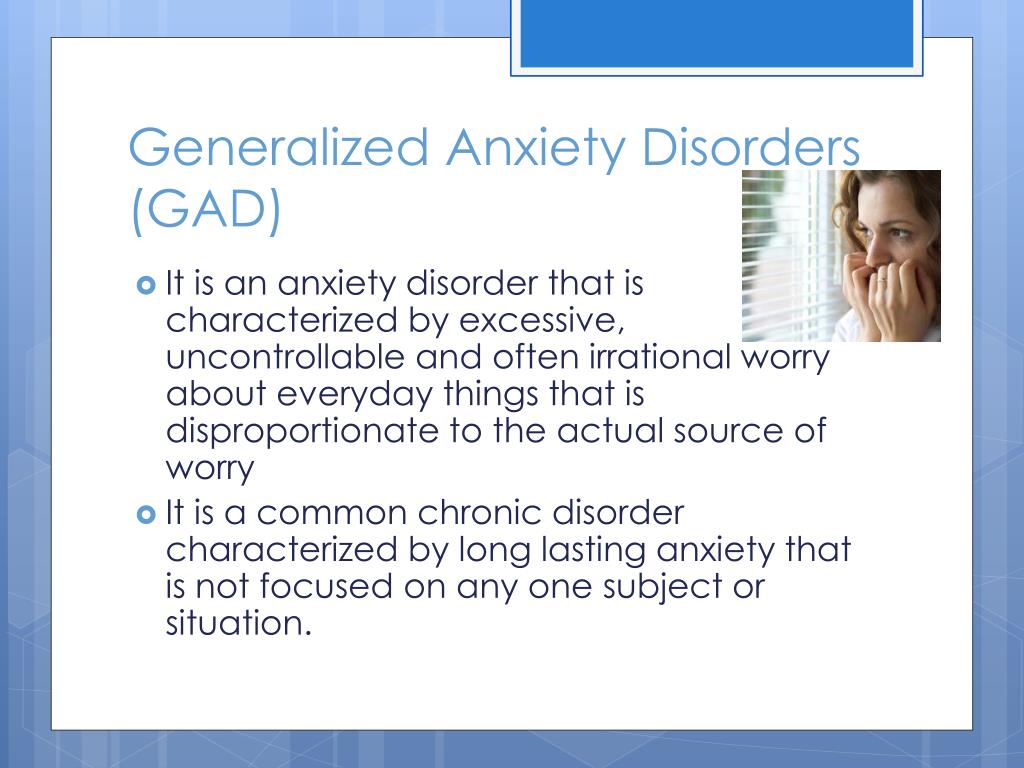 21.
21.
• Obsessive-compulsive disorder (300.3) — involves persistent, recurring thoughts/impulses (obsessions) and ritualistic actions (compulsions). This is different than obsessive-compulsive personality disorder (301.4).
• Posttraumatic stress disorder (309.81) — occurs after a severe emotional or physical trauma and involves the feeling that the person is reexperiencing this traumatic event.
• Acute stress disorder (308.3) — includes similar symptoms to posttraumatic stress disorder but occurs immediately after a traumatic event.
• Social phobia (300.23) — a person may experience anxiety when exposed to certain social events and desires to avoid the situation.
• Other phobia (300.2x) — anxiety when exposed to a specific object or situation and the desire to avoid it.
• Alcohol-induced anxiety (291.89)
• Drug-induced anxiety (292.89)
• Separation anxiety (309.21) — occurs when a child is separated from his or her parents.
Most frequently, the physician simply documents anxiety, which is classified to code 300. 00. In some instances, anxiety is caused by an underlying medical condition. If that is the case, a code for both the anxiety and medical condition may be assigned. Sequencing will depend on the circumstances of admission. Common medical conditions causing anxiety include asthma, diabetes, heart disease, hyperthyroidism, and hypothyroidism.
00. In some instances, anxiety is caused by an underlying medical condition. If that is the case, a code for both the anxiety and medical condition may be assigned. Sequencing will depend on the circumstances of admission. Common medical conditions causing anxiety include asthma, diabetes, heart disease, hyperthyroidism, and hypothyroidism.
Anxiety may be associated with depression. If both are documented by a physician, assign codes 311 and 300.00. However, if the physician links the two conditions, such as “depression with anxiety,” then code 300.4, Dysthymic disorder, may be assigned (AHA Coding Clinic for ICD-9-CM, 2001, third quarter, page 6).
Symptoms, Diagnosis, and Treatment
Common signs and symptoms of anxiety include feelings of apprehension, powerlessness, panic, or fear; hyperventilation; inability to be still or calm; increased heart rate; muscle tension; sweating; tiredness/weakness; and trembling.
A diagnosis of anxiety is made with a physical examination and psychological evaluations.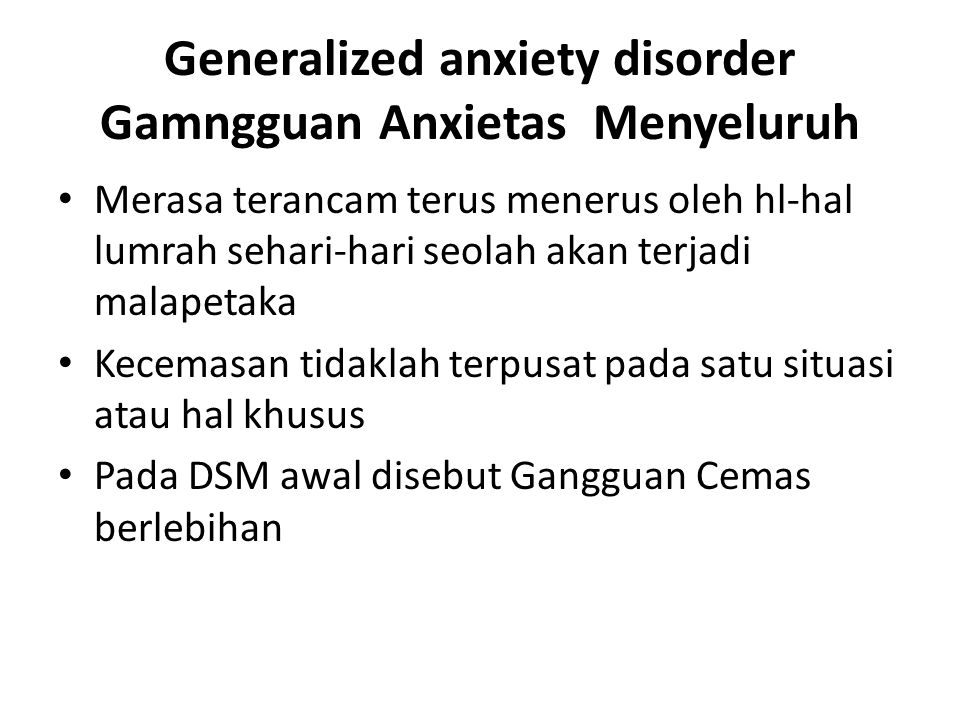 The physical examination and diagnostic tests, if necessary, are performed to rule out other conditions that may mimic an anxiety state. Anxiety can lead to other medical conditions such as constipation, diarrhea, depression, drug/alcohol abuse, headaches, and insomnia.
The physical examination and diagnostic tests, if necessary, are performed to rule out other conditions that may mimic an anxiety state. Anxiety can lead to other medical conditions such as constipation, diarrhea, depression, drug/alcohol abuse, headaches, and insomnia.
Coding and sequencing for anxiety disorders are dependent on the physician documentation in the medical record and application of the Official Coding Guidelines for inpatient care. Also, use specific AHA Coding Clinic for ICD-9-CM and American Medical Association CPT Assistant references to ensure complete and accurate coding.
— This information was prepared by Audrey Howard, RHIA, of 3M Consulting Services. 3M Consulting Services is a business of 3M Health Information Systems. More information about 3M Health Information Systems is available at www.3mhis.com or by calling 800-367-2447.
ICD-10-CM Coding for Anxiety and Depression
Anxiety is classified to ICD-10-CM category F41 and is similar in structure in ICD-10-CM as in ICD-9-CM; one difference is anxiety with depression.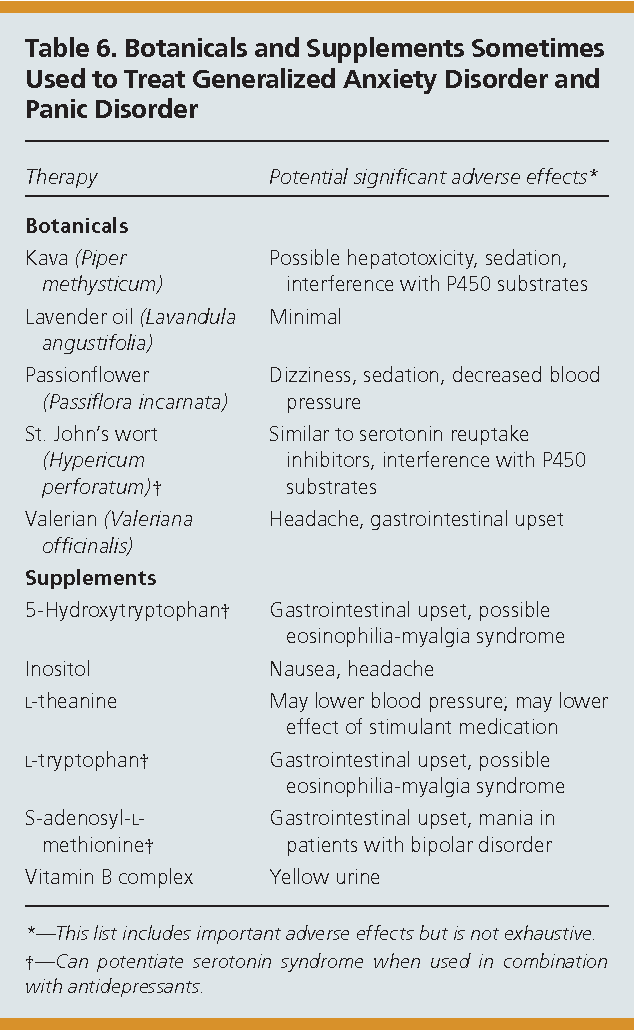 Two codes are available depending on severity: F34.1, Persistent anxiety depression, and F41.8, Anxiety depression (mild or not persistent).
Two codes are available depending on severity: F34.1, Persistent anxiety depression, and F41.8, Anxiety depression (mild or not persistent).
Dysthymic disorder also is classified to code F34.1 and includes depressive neurosis, depressive personality disorder, dysthymia, neurotic depression, and persistent anxiety depression.
In ICD-10-CM, coding for depression requires specific documentation as to type and acuity. The default for unspecified depression is major depressive disorder, single episode (F32.9), which also includes depressive disorder not otherwise specified (NOS) and major depression NOS. Physician education as well as queries for clarification will be most helpful in accurate documentation of a type and acuity of depression to avoid misrepresentation of a less severe disorder as a major one.
— AH
Generalized Anxiety Disorder - Treatment, Symptoms, Causes, Early Signs
Generalized Anxiety Disorder - Treatment, Symptoms, Causes, Early SignsHome
Disease reference
Generalized anxiety disorder
Description
- Description
- Symptoms
- Treatment
- Who treats
- where to treat
Published: August 25, 2021 Reading time: 7 minutes It is characterized by a constant feeling of internal tension, expectation of something bad, sleep and appetite disturbances, headaches and chest discomfort.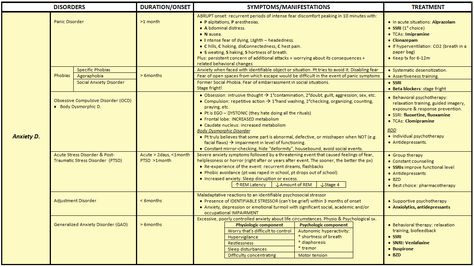 The ICD-10 code for this disorder is F41.1.
The ICD-10 code for this disorder is F41.1.
The prevalence of generalized anxiety disorder is quite high: according to various sources, it ranges from 3 to 7% in the general population. Women are diagnosed twice as often as men. The peak incidence occurs in adolescence, and after 30 years, the disorder is extremely rare.
The development of generalized anxiety disorder is associated with the influence of biological and psychosocial factors. It has been proven that there is a genetic predisposition to increased anxiety, but it is not the disorder itself that is inherited, but some personality traits: high susceptibility to disturbing stimuli, a tendency to respond to minor changes in the external environment, and emotional instability. Patients often have an unstable weak type of nervous system (melancholic temperament). External environmental factors that provoke increased anxiety include:
- Parenting style. Anxiety is high in children whose parents tend to be overprotective.
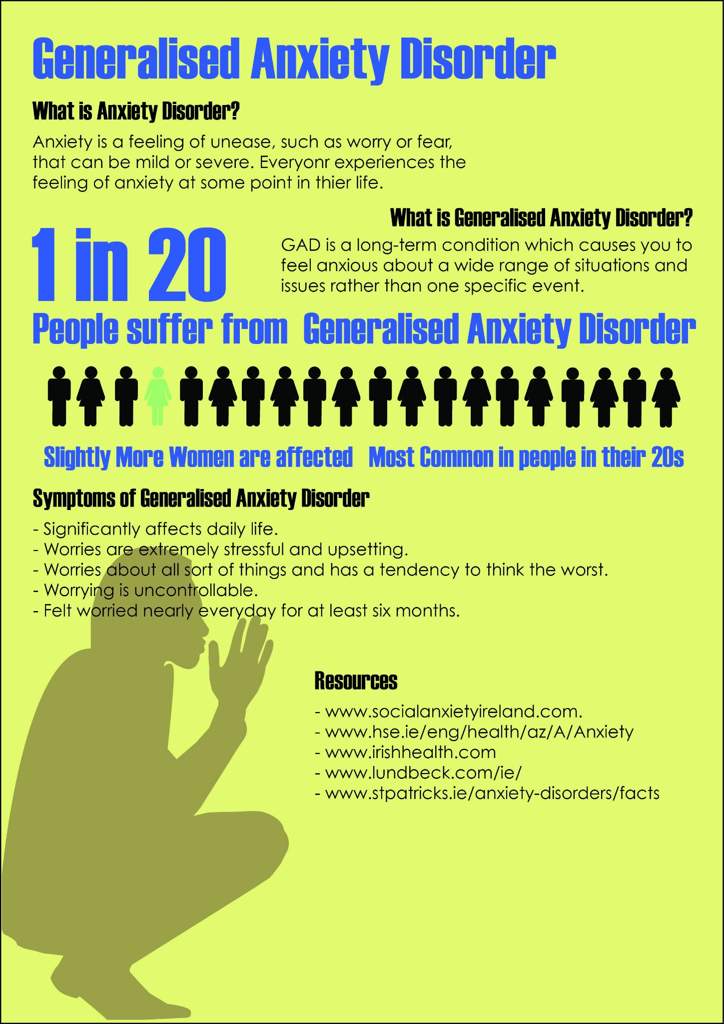 The overprotective behavior of parents creates in the child the feeling that the whole world is dangerous, full of difficulties that cannot be dealt with on their own. This parenting style is typical for families in which one or both parents have elevated levels of anxiety.
The overprotective behavior of parents creates in the child the feeling that the whole world is dangerous, full of difficulties that cannot be dealt with on their own. This parenting style is typical for families in which one or both parents have elevated levels of anxiety. - Family relations. Generalized anxiety disorder is often diagnosed in children and adolescents who are accustomed to unpredictable parental behavior. This is observed in alcoholism, drug addiction, mental illness, destructive intra-family relationships in which spouses often quarrel, are on the verge of divorce.
- Traumatic events. Increased anxiety arises as a result of super-strong experiences experienced in early childhood, for example, caused by a serious illness, violence, separation from the mother, divorce of parents.
The pathogenetic mechanisms of generalized anxiety disorder remain unclear. It has been established that in patients with anxiety disorders, the activity of the main inhibitory neurotransmitter, gamma-aminobutyric acid, is insufficient, and the sensitivity of its receptors is also reduced.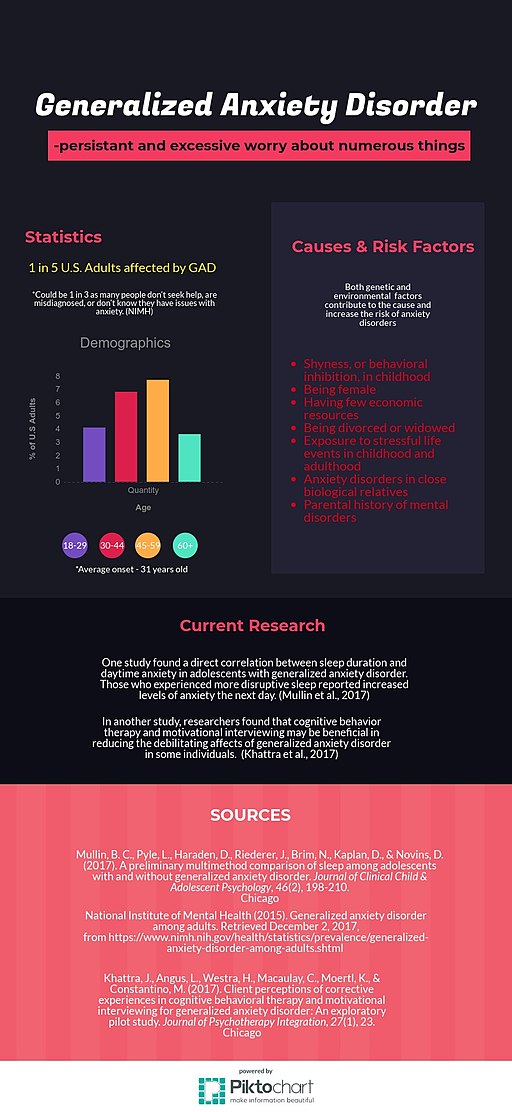 In addition, there is hyperactivity of the hypothalamic-pituitary-adrenal axis, as a result of which cortisol, the stress hormone, is produced in excess. Thus, at the physiological level, the central nervous system is in a state of tension and excitement.
In addition, there is hyperactivity of the hypothalamic-pituitary-adrenal axis, as a result of which cortisol, the stress hormone, is produced in excess. Thus, at the physiological level, the central nervous system is in a state of tension and excitement.
Symptoms
Photo: vk.com
Generalized anxiety disorder develops gradually, symptoms grow slowly and are chronic. The main manifestation is conscious excessive anxiety, which is felt almost constantly, regardless of external events and situations. Patients feel anxiety that they cannot control and explain. They experience tension, are in a state of expectation of something bad, fear the future.
Increased anxiety is called generalized, because fears and anxiety concern all spheres of life, are not justified by the situation and are not adequate to life circumstances. The reasons can be varied: the expectation of an accident, a serious illness, professional and personal failures. Young people often worry about dropping out of school, even if they have good grades.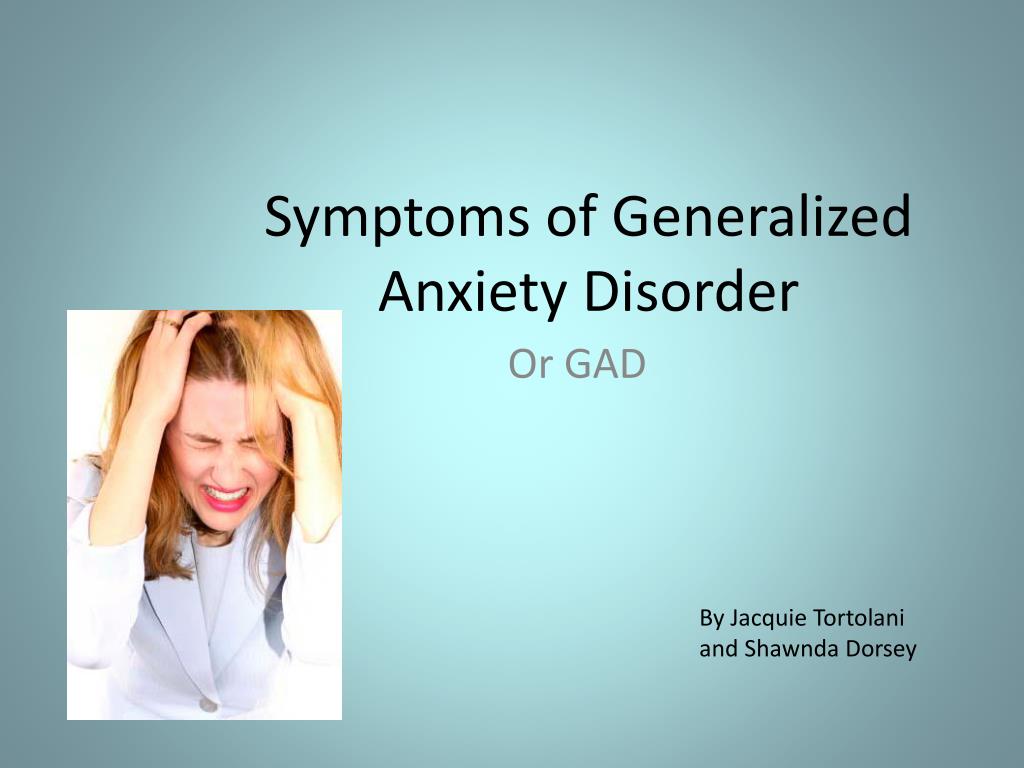 Anxious anticipation of problems and unreasonable fears are uncontrollable. Their probability is always estimated by patients as higher than in reality. Increased anxiety never exists in isolation, it manifests itself in combination with other symptoms:
Anxious anticipation of problems and unreasonable fears are uncontrollable. Their probability is always estimated by patients as higher than in reality. Increased anxiety never exists in isolation, it manifests itself in combination with other symptoms:
- Motorized. There is muscle tension and pain. Patients are restless and restless, perform stereotypical actions to reduce anxiety (biting their nails, sorting out the edge of clothing, shifting things from one place to another).
- Vegetative. Patients complain of palpitations, tachycardia, bouts of dizziness and shortness of breath, hot flashes, chills, feeling cold in the extremities, frequent urination, excessive sweating. Many find it difficult to fall asleep in the evenings, and sleep is interrupted and superficial. Symptoms from the gastrointestinal tract: nausea, gas formation, discomfort and pain in the stomach, intestines.
- Motivational. It is difficult for patients to concentrate, concentrate on a certain activity, so they often do not bring their plans to the end.
 Fear and anxiety reduce the motivation to do anything.
Fear and anxiety reduce the motivation to do anything. - Cognitive. The thinking of people with an anxiety disorder becomes very subjective. Most events are assessed as potentially dangerous, there is a tendency to think about the same thing for a long time (“thinking chewing gum”). Often attention is drawn to disturbing thoughts, so current events are not fully perceived and remembered.
- Emotional. Patients experience fear of losing control over their own behavior and emotions, fear of insanity. They become irritated and agitated, and often feel tired. Often there are depressive experiences.
Diagnosis
Photo: pokadepressiya.ru
Generalized anxiety disorder develops gradually, so patients first of all begin to pay attention to vegetative symptoms caused by mental stress. They seek help from therapists, cardiologists, neurologists, complaining of pain, discomfort in the chest and / or abdomen, shortness of breath, nausea, dizziness, etc.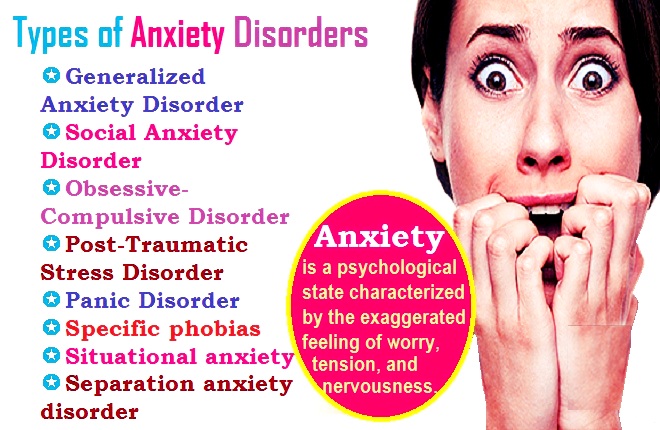 For this reason, the true diagnosis is established late, a year or more after the onset of anxiety. disorders. By the time of contacting a psychiatrist, patients undergo many diagnostic procedures and also symptomatic treatment by specialists of various profiles.
For this reason, the true diagnosis is established late, a year or more after the onset of anxiety. disorders. By the time of contacting a psychiatrist, patients undergo many diagnostic procedures and also symptomatic treatment by specialists of various profiles.
To make a diagnosis, the psychiatrist uses clinical research methods (talk, observation, anamnesis). Generalized anxiety disorder is confirmed by the presence of the following symptoms:
- excessive anxiety and worry associated with several areas of life, observed for 6 months or longer;
- uncontrollable anxiety;
- restlessness and anxiety associated with three or more of the following for 6 months or more:
- inability to sit still, feeling excited;
- excessive fatigue;
- deterioration in the ability to concentrate, concentrate;
- irritability;
- feeling of muscular tension;
- sleep disorders (difficulty falling asleep, frequent awakenings at night).
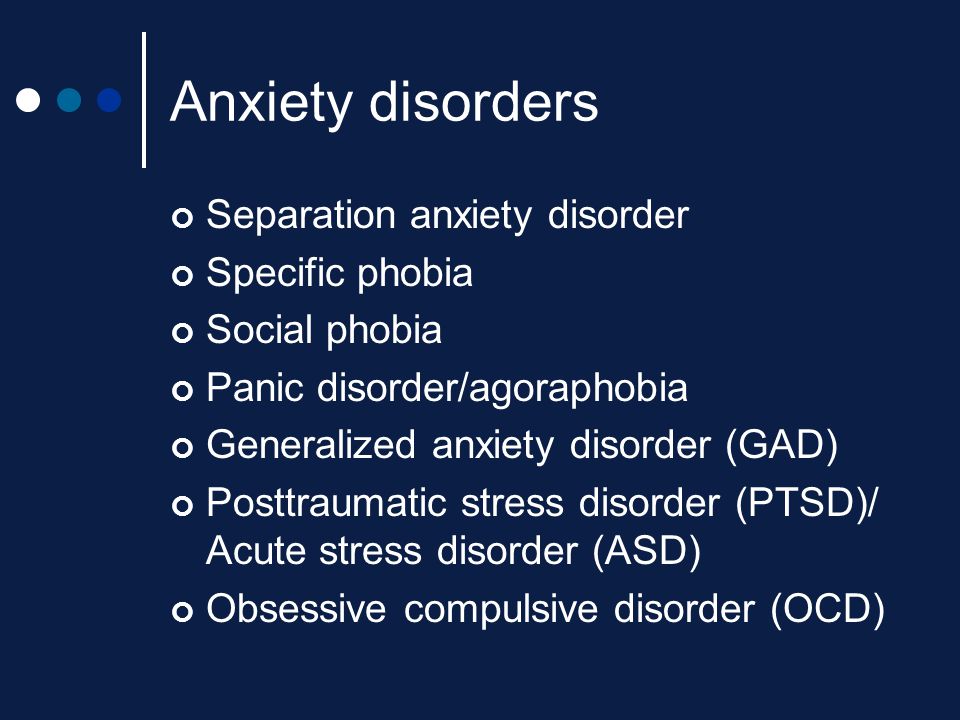
- Anxiety and anxiety are not associated with panic attacks, social phobia, obsessive-compulsive disorder, anorexia nervosa, somatic diseases (eg, endocrine), hypochondria, post-traumatic stress disorder.
- anxiety and anxiety, as well as their physical manifestations, are a source of distress, disrupt the patient's socialization in the family, at work, in an educational institution and in other areas;
- Anxiety symptoms are not caused by drugs or other substances, are not a manifestation of somatic diseases, depression, psychotic disorders.
Treatment
Photo: zen.yandex.ru
Patients with generalized anxiety disorder are indicated for psychotherapy and drug correction of their emotional state. Hospitalization is not required, all therapeutic measures are carried out on an outpatient basis. Among psychotherapeutic directions the most effective are:
- Rational psychotherapy. The specialist forms the patient's idea of anxiety as a natural reaction of the body, which has positive and negative functions.
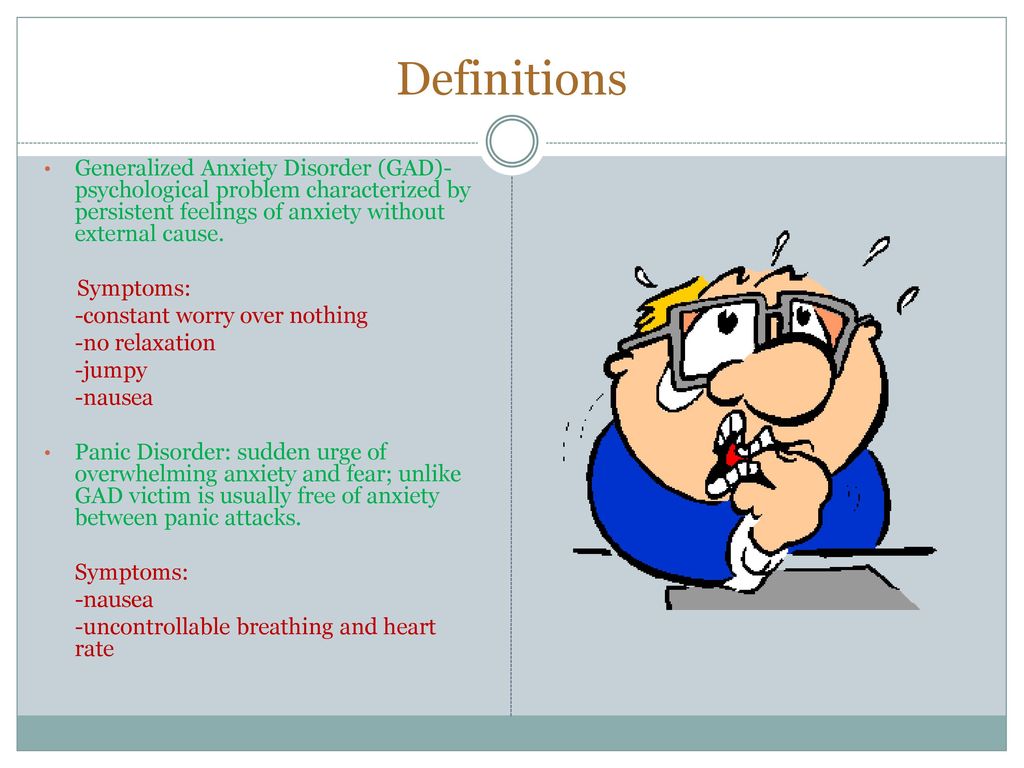 The psychotherapist emphasizes that all symptoms are reversible, helps to change the attitude towards possible events in the future and switch attention from anxiety to events in the present.
The psychotherapist emphasizes that all symptoms are reversible, helps to change the attitude towards possible events in the future and switch attention from anxiety to events in the present. - Cognitive-behavioral psychotherapy. The specialist helps to deal with destructive thought patterns that affect perception, emotions and behavior. Observing the process of thought formation, the emergence of anxiety and anxiety allows the patient to begin to control the symptoms of the disorder.
- Breathing techniques. To reduce the frequency and severity of autonomic symptoms and attacks of increased anxiety, the patient is taught breathing techniques and muscle relaxation. The purposeful restoration of a calm, even rhythm of inhalations and exhalations, as well as the conscious relaxation of all muscle groups, entails a change in the emotional state: anxiety decreases, a person begins to perceive what is happening in the present moment better.
The main component of drug therapy for generalized anxiety disorder is tranquilizers.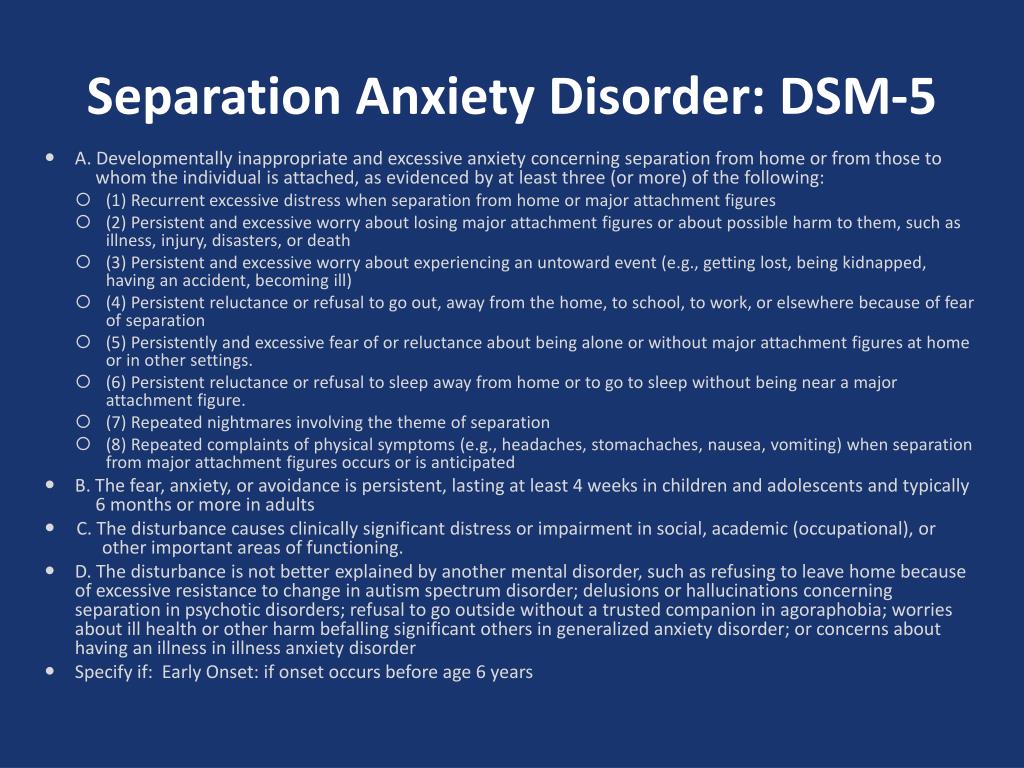 Preparations of this group reduce the manifestations of anxiety, eliminate emotional tension and fears. Benzodiazepine tranquilizers are effective in relieving symptoms, but have many side effects, and after withdrawal can provoke a resumption of anxiety with greater severity. For this reason, non-benzodiazepine anxiolytics, such as histamine H1 receptor antagonists, may be prescribed. They reduce anxiety and some autonomic symptoms, but cause drowsiness and lethargy. Additionally, antidepressants from the group of selective serotonin reuptake inhibitors are used. They also have anxiolytic effects.
Preparations of this group reduce the manifestations of anxiety, eliminate emotional tension and fears. Benzodiazepine tranquilizers are effective in relieving symptoms, but have many side effects, and after withdrawal can provoke a resumption of anxiety with greater severity. For this reason, non-benzodiazepine anxiolytics, such as histamine H1 receptor antagonists, may be prescribed. They reduce anxiety and some autonomic symptoms, but cause drowsiness and lethargy. Additionally, antidepressants from the group of selective serotonin reuptake inhibitors are used. They also have anxiolytic effects.
Prognosis
Generalized anxiety disorder occurs in a chronic form, requires long-term drug treatment and psychotherapy. Most patients manage to achieve an improvement in well-being and even the complete elimination of symptoms of anxiety and anxiety. However, there are cases that are resistant to tranquilizer therapy. Such patients need to be re-diagnosed and identify comorbid disorders that should be targeted by drug correction (for example, depression or panic attacks).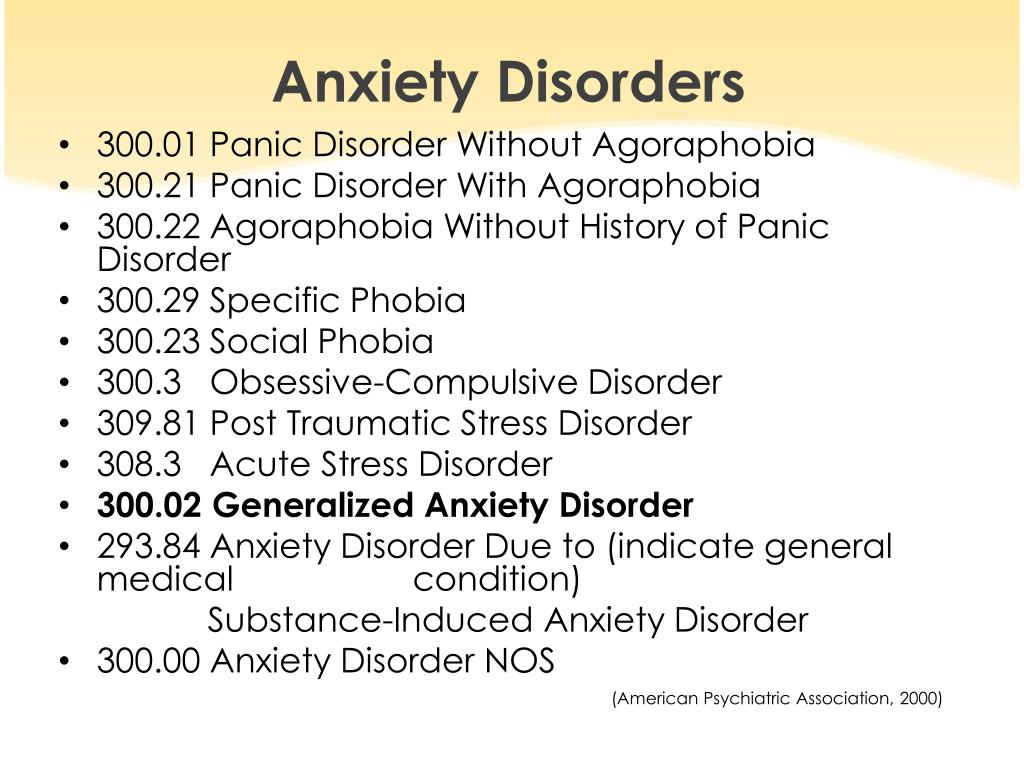
The information is for reference only and is not a guide to action. Do not self-medicate. At the first symptoms of the disease, consult a doctor.
References
- Chutko L. S., Rozhkova A. V., Sidorenko V. A., Surushkina S. Yu., Tursunova K. B. Generalized anxiety disorder: psychosomatic aspects and approaches to treatment. Journal of Neurology and Psychiatry. S.S. Korsakov. 2012; 112(1):40-44.
- Uskenbaeva Zh.S. Generalized Anxiety Disorders: Clinic and Therapy // Vestnik AGIUV. 2012. №2.
- Almagambetova A.A., Toleubaeva Sh.B., Sataeva S.K., Pavlyukova E.A. Clinical features and therapy of generalized anxiety disorder // Science and Health. 2013. No. 4.
- Levin O.S. Generalized anxiety disorder: diagnosis, comorbidity and treatment // STPN. 2016. №2.
- Voznesenskaya Tatyana Gratsievna Generalized anxiety disorder: differential diagnosis and treatment // Neurology, neuropsychiatry, psychosomatics. 2013. No. 2.
Your comments about symptoms and treatment
If you notice a mistake in the text, please highlight it and press Ctrl+Enter
Found error
Anxiety disorder: symptoms, diagnosis and treatment
Psychotherapist
Krashkina
Irina Ivanovna
Experience 31 years
Psychotherapist, candidate of medical sciences, member of the Russian Professional Psychotherapeutic League
Make an appointment
Anxiety disorder is a type of neurotic condition in which a person experiences continuous anxiety about life circumstances, their appearance and relationships with people around them.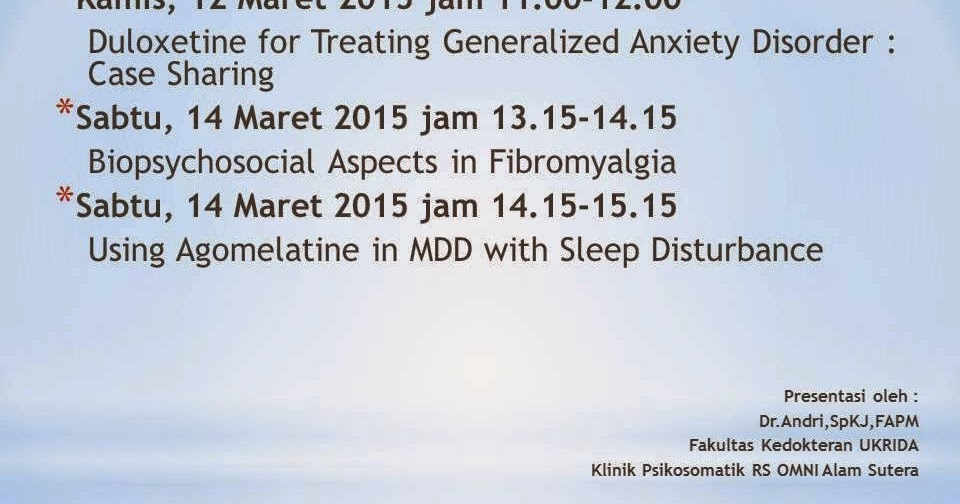 Staying in this state for a long time creates uncomfortable living conditions for a person, which become the reason for him to withdraw into himself, not to develop his own abilities and limit his social circle.
Staying in this state for a long time creates uncomfortable living conditions for a person, which become the reason for him to withdraw into himself, not to develop his own abilities and limit his social circle.
Symptoms and signs
It is believed that when an anxiety disorder appears, the symptoms are as follows:
- severe form of anxiety and emotional stress before the onset of panic attacks;
- frequent mood swings;
- persistent sleep disorder;
- constant conflicts with others;
- reduced acuity of reactions and inhibited thinking;
- increased sweating, rapid pulse;
- fatigue and weakness, leading to a decrease in performance;
- complaints about the appearance of pain in different parts of the body.
These symptoms of an anxiety disorder are signs of autonomic and mental disorders.
The hallmarks of symptoms of generalized anxiety disorder are:
- total manifestation of anxiety before any life circumstances;
- inability to concentrate on domestic activities or work;
- constant motor voltage;
- inability to relax;
- indigestion and stomach pain;
- heart disease.
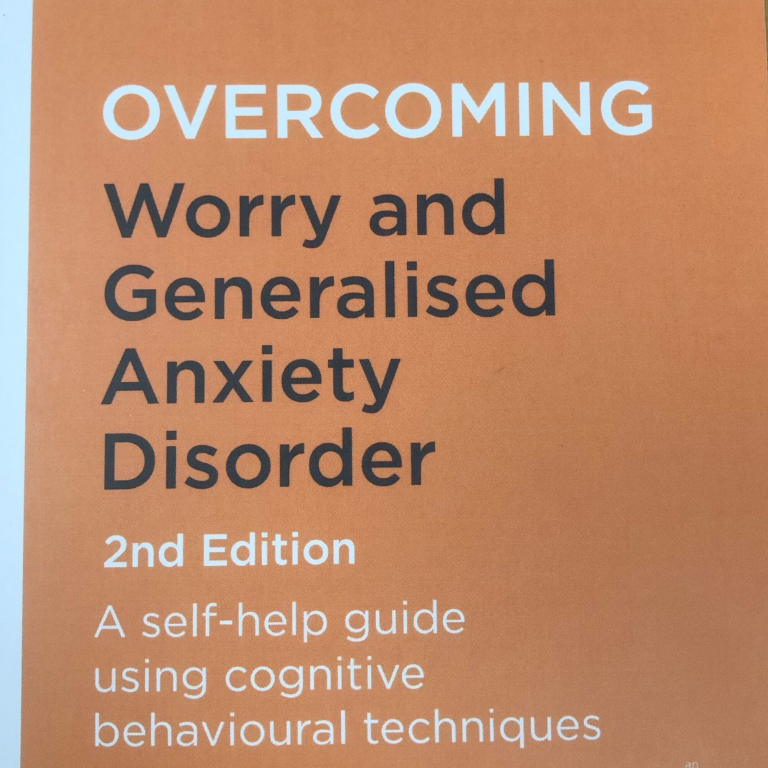
Symptoms of an anxiety-depressive disorder occur against the background of constant depression:
- lack of interest in the manifestations of life and close people;
- lack of positive emotions;
- sudden feeling of fear;
- vegetative disorders - rapid pulse, shortness of breath, shortness of breath, increased sweating, proximity to fainting, etc.
Causes of the onset and development of the disease
Experts believe that the following factors contribute to the appearance of the disease:
- the presence of persistent circulatory disorders, hormonal failures or chronic heart disease;
- a chronic form of dependence on alcohol, drugs, psychoactive substances, as well as a sharp cessation of their use;
- traumatic brain injuries and their consequences;
- being in a situation of prolonged stress;
- character traits - melancholic temperament, disturbing accents in the temperament of the character;
- tendency to exaggerate dangers due to their high susceptibility;
- neurotic and mental disorders: depression, neurasthenia, hysteria, schizophrenia, paranoia, various manias;
- mental trauma in children at an early age and in adults in extreme situations - war, earthquake, being in a state close to death, loss of a loved one or his support, and others.
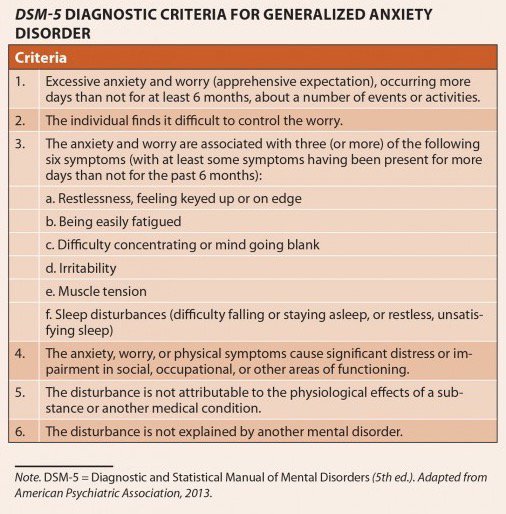
Psychologists view the process of anxiety in different ways:
- adherents of psychoanalysis believe that the reason is the regular suppression of their own desires;
- the second believe that the reason is the break in the connection between the stimulus and the response of the psyche to the stimulus;
- still others believe that the reason is in the reaction of the psyche to the distorted mental images of a person.
Disease classification
Anxiety disorder according to the ICD is a neurotic disorder along with fears, suspiciousness and post-traumatic disorders. One of the main signs of an anxious personality disorder is the pathology of the origin of anxiety, the disproportionate degree of protection to the stimulus factor.
Pathological anxiety:
- not caused by real danger;
- is not proportionate to the significance of the situation;
- is not associated with a lack of time and knowledge;
- is being actively ousted;
- brings significant discomfort to a person's life;
- is much more pronounced than normal;
- is long in time;
- has satellites in the form of tension and expectation of consequences, concern and doubt, feelings of helplessness.
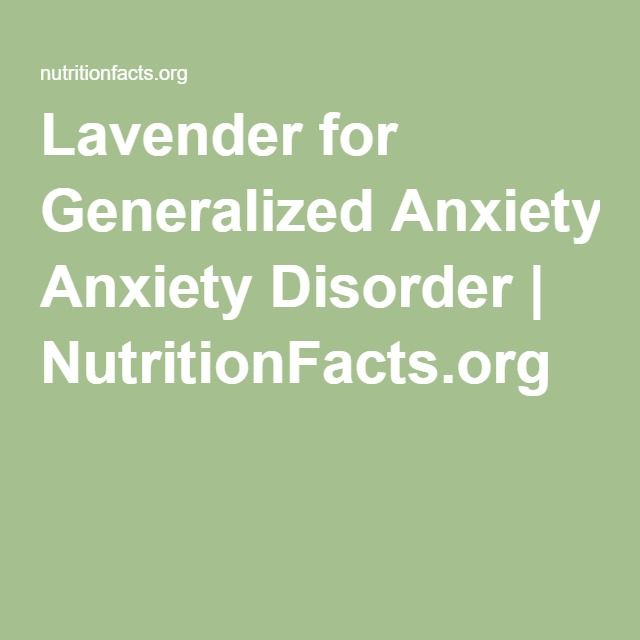
Types of anxiety disorder:
- anxiety-depressive disorder is caused by the constant presence of anxiety without sources of danger, has pathological changes in the patient's personality;
- phobic anxiety disorder is based on dwelling on past unpleasant consequences;
- social anxiety disorder is characterized by the patient's avoidance of contact with other people;
- mixed anxiety disorder causes a simultaneous feeling of pathological anxiety and depressed mood;
- anxiety-panic disorder is characterized by the presence of panic attacks;
- Anxiety-neurotic disorder is associated with anxiety before any diseases, severe shyness and unrest;
- generalized anxiety disorder is accompanied by excessive fussiness, anxiety without certain dangers and threats.
Risk factors and groups
Risk factors include child abuse, hereditary mental disorders, historical family poverty, or other antisocial manifestations.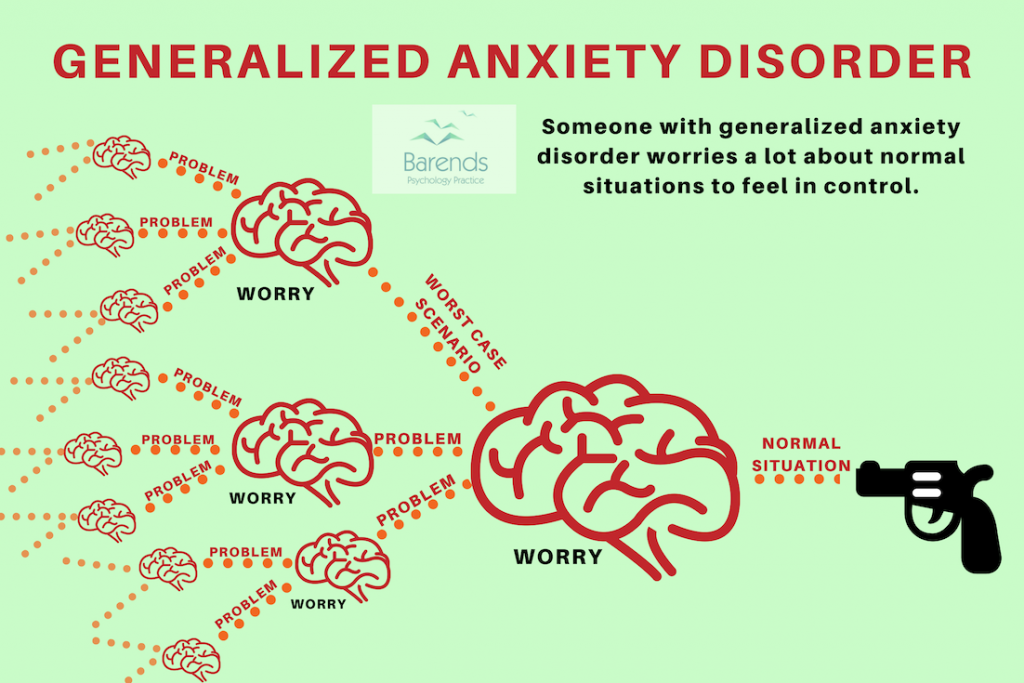
The risk group includes people prone to neurotic diseases - depression, hysteria; people taking alcohol, drugs, psychotropic drugs; women between the ages of 20 and 30.
Complications
In the absence of adequate treatment, anxiety disorder leads to the following socio-psychological complications:
- low self-esteem;
- self-isolation from society;
- insomnia;
- the appearance of a feeling of hopelessness;
- exhaustion of the body.
Social complications are job loss, financial problems, relationship breakdown, alcoholism, drug addiction, substance abuse, and others. Physical complications - irritation in the intestines, heartburn, lack of interest in sex, weight loss or excess weight gain, headaches and muscle strain, decreased immunity, the development of allergies, accelerated aging, cancer, heart disease and many others.
Diagnostics
The accumulated information about this disease made it possible to test reliable methods of drug and psychotherapeutic treatment.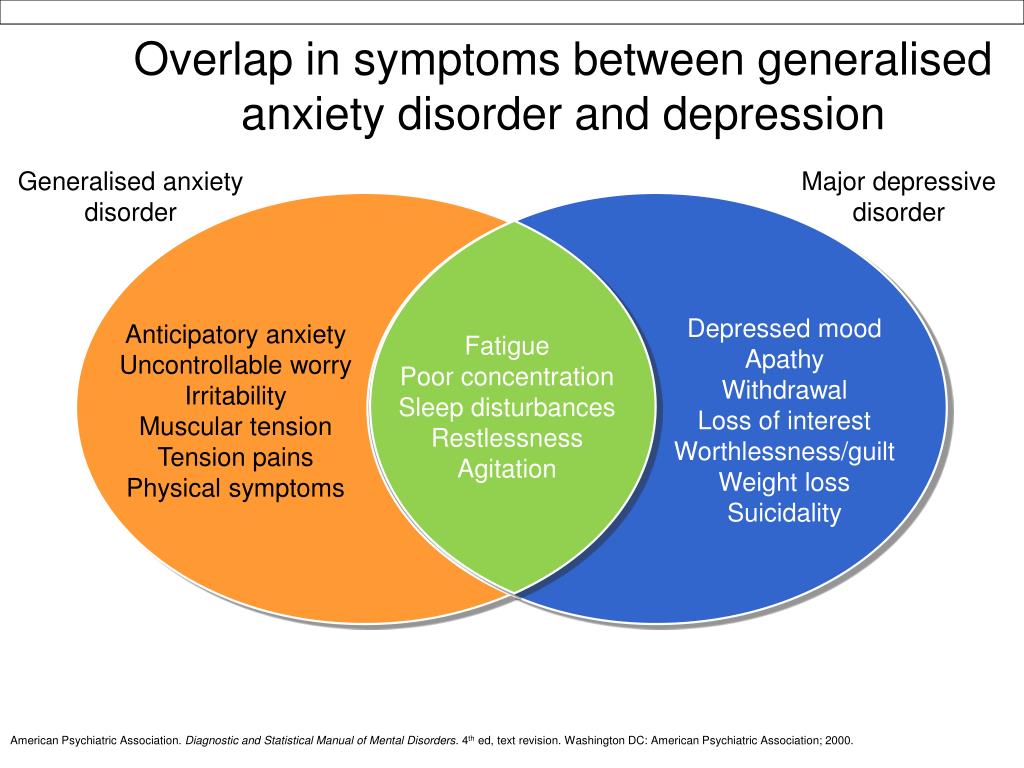 This disease belongs to the areas of professional interest of a psychiatrist and a medical psychologist.
This disease belongs to the areas of professional interest of a psychiatrist and a medical psychologist.
Specialists use the following methods for diagnosing a neurotic disease:
- initial individual consultation involves a survey to identify emotional reactions, obtain information about the patient's lifestyle, motives and interests;
- psychodiagnostic examination and projective testing aimed at identifying pathological anxiety and associated disorders;
- observation of the patient and his life, relationships with the outside world and with people.
Preparing to see a doctor
Before entering the psychotherapist's office, the patient is advised to formulate all his problems, report on the use of all psychoactive substances, including the start/end dates and the total duration of the use. In addition, the positive attitude of the patient to the treatment and the effect that it will bring is extremely important.
Treatment
Anxiety disorders are treated with a complex of methods based on changing the patient's lifestyle, psychotherapy and taking medications. Treatment for generalized anxiety disorder is based on the use of psychoactive-type medications, such as antidepressants. In no case should you arbitrarily stop taking medications. Psychotherapy of anxiety disorder is carried out by various methods - individual, group, family. The main direction of the impact of therapy is an increased impact on the attitude towards the fears and anxieties that have appeared.
Among traditional medicine, it is possible to use medicinal herbs, infusions and decoctions from them, for example, lemon balm, chamomile. These herbs act on the human body, bringing a relaxing effect, thanks to this effect, anxiety disorders and their cause temporarily reduce their degree of activity.
Self-treatment of an anxiety disorder threatens with pains and neuroses of a different nature, which need to be treated more deeply.


